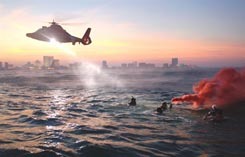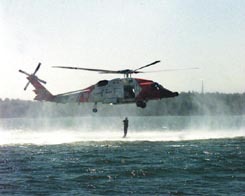
The United States Coast Guard (USCG) is a military branch of the United States involved in maritime law, mariner assistance, and search and rescue, among other duties of coast guards elsewhere.
One of the seven uniformed services of the United States, and the smallest armed service of the United States, its stated mission is to protect the public, the environment, and the United States economic and security interests in any maritime region in which those interests may be at risk, including international waters and America's coasts, ports, and inland waterways.
- Hurricane Katrina. Search and rescue operations alone saved 24,135 lives from imminent danger, usually off the roofs of the victims' homes as flood waters lapped at their feet. Coast Guardsmen "evacuated to safety" 9,409 patients from local hospitals. In total, 33,545 lives were saved. Seventy-six Coast Guard and Coast Guard Auxiliary aircraft took part in the rescues. They flew 1,817 sorties with a total flight time of 4,291.3 hours in the air. The air crews saved 12,535. A total of 42 cutters and 131 small boats also participated, with their crews rescuing 21,200. More than 5,000 Coast Guardsmen served in Katrina operations.
- Prinsendam Rescue. A fire broke out on the Dutch cruise vessel Prinsendam off Ketchikan, Alaska, on Oct. 4, 1980. The Prinsendam was 130 miles from the nearest airstrip. The cruise ship's captain ordered the ship abandoned and the passengers, many elderly, left the ship in the lifeboats. Coast Guard and Canadian helicopters and the cutters Boutwell, Mellon, and Woodrush responded in concert with other vessels in the area. The passenger vessel later capsized and sank. The rescue is particularly important because of the distance traveled by the rescuers, the coordination of independent organizations and the fact that all 520 passengers and crew and crew were rescued without loss of life or serious injury.
- Pendleton Rescue. On Feb. 18, 1952, during a severe "nor'easter" off the New England coast, the T-2 tankers Fort Mercer and Pendleton broke in half. Boatswain's Mate 1st Class Bernard C. Webber, coxswain of motor lifeboat CG-36500 from Station Chatham, Mass., and his crew of three rescued the crew of the Pendleton. Webber maneuvered the 36-footer under the Pendleton's stern with expert skill as the tanker's crew, trapped in the stern section, abandoned the remains of their ship on a Jacob's ladder. One by one, the men jumped into the water and then were pulled into the lifeboat. Webber and his crew saved 33 of the 34 Pendleton crewmen. Webber and entire crew were awarded the Gold Lifesaving Medal for their heroic actions. In all, U.S. Coast Guard vessels, aircraft, and lifeboat stations, working under severe winter conditions, rescued and removed 62 persons from the foundering ships or from the water with a loss of only five lives. Five Coast Guardsmen earned the Gold Lifesaving Medal, four earned the Silver Lifesaving Medal, and 15 earned the Coast Guard Commendation Medal.
- Dorchester Rescue. On Feb. 3, 1943, the torpedoing of the transport Dorchester off the coast of Greenland saw cutters Comanche and Escanaba respond. The frigid water gave the survivors only minutes to live in the cold North Atlantic. With this in mind, the crew of Escanaba used a new rescue technique when pulling survivors from the water. This "retriever" technique used swimmers clad in wetsuits to swim to victims in the water and secure a line to them so they could be hauled onto the ship. Escanaba saved 133 men (one died later), and Comanche saved 97.
- Joshua James and the Hull, Mass., Life Saving Station (Nov. 25-26, 1888). Over the two day period, Keeper Joshua James and his crew, by their zealous and unswerving work, rescued some 28 people from five different vessels during a great storm. In addition to the number of individuals rescued, the number of vessels involved, the weather conditions, and the duration of their efforts, James and his crew conducted differing types of rescues which included the employment of the beach apparatus and rescue by boat. For their versatility, endurance, skill, and dedication, James and his crew were awarded the Gold Lifesaving Medal.
- The Priscilla Rescue. On Aug. 18, 1899, Surfman Rasmus S. Midgett, from the Gull Shoal Life-Saving Station, N.C., was conducting a beach patrol on horseback and came upon the barkentine Priscilla, which had run aground. Given his distance from the station, he determined to do what he could alone. Immediately, he ran as close to the wreck as he could and shouted instructions for the men to jump overboard one at a time as the waves receded. Obeying his instructions, the sailors leapt overboard. Midgett seized each man and dragged him from the pursuing waves safely to the beach. In this manner, he rescued seven men. There were still three men on board who were too weak to get off the vessel. Midgett went into the water and carried each of them to the beach. For the 10 lives he saved, Midgett was subsequently awarded a Gold Lifesaving Medal.
- Keeper George N. Gray and the Charlotte, NY, Life Saving Station (Dec. 14-15, 1902). The crew received the Gold Lifesaving Medal in recognition of their rescue of four men and one woman from the wreck of the schooner John R. Noyes. They were engaged for more than a day and a night with little sleep, having been under oars from 11:30 p.m. on the 14th to 4:30 p.m. on the 15th with the exception of about two hours. They pulled in a heavy seaway for nearly 60 miles, and all were covered in ice and were frostbitten. In addition to the conditions and distances rowed, the keeper commandeered a train and sleds to move the beach cart and equipment through the deep snow drifts for the launching of the surfboat.
- Overland Rescue. In 1897, eight whaling ships were trapped in the Arctic ice near Point Barrow, Alaska. Concerned that the 265 crewmen would starve during the winter, the whaling companies appealed to President William McKinley to send a relief expedition. The cutter Bear sailed northward from Port Townsend, Wash., in late November 1897. With no chance of the cutter pushing through the ice to Point Barrow, it was decided to put a party ashore and have them drive reindeer to Point Barrow. Lt. David H. Jarvis was placed in charge. He was joined by fellow officers Lt. Ellsworth P. Bertholf and Surgeon Samuel J. Call along with three other men. Using sleds pulled by dogs and reindeer, snowshoes, and skis, the men began the expedition on Dec. 16 and arrived at Point Barrow, 1,500 miles later, on March 29, 1898. The expedition managed to bring 382 reindeer to the whalers, having lost only 66. For their work, Bertholf, Call, and Jarvis received a gold medal from the Congress
- Bermuda Sky Queen Rescue (Oct. 14, 1947). The American-owned flying boat Bermuda Sky Queen, carrying 69 passengers, was flying from Foynes, Ireland, to Gander, Newfoundland. Gale-force winds had slowed its progress, and it was running low on fuel. Too far from Newfoundland and unable to make it back to Ireland, the captain decided to fly toward the cutter Bibb which was on Ocean Station Charlie in the North Atlantic. The plane's captain decided to ditch and have his passengers and crew picked up by the Bibb. In 30-foot seas, the transfer was both difficult and dangerous. Initially, the Bibb's captain tried to pass a line to the plane which taxied to the lee side of the cutter. A collision with the cutter ended this attempt to save the passengers. With worsening weather, a 15-man rubber raft and a small boat were deployed from the ship. The raft was guided to the escape door of the aircraft. Passengers jumped into the raft, which was then pulled to the boat. After rescuing 47 of the crew, worsening conditions and the approach of darkness forced the rescue's suspension. By dawn, improved weather allowed the rescue to resume, and the remaining passengers and crew were transferred to the Bibb. The rescue made headlines throughout the country, and upon their arrival in Boston, Bibb and her crew received a hero's welcome for having saved all those aboard the ditched Bermuda Sky Queen.
- 1937 Mississippi River Flood. During the disastrous 1937 Mississippi River flood, the Coast Guard rescued a total of 43,853 persons who were "removed from perilous positions to places of safety". Additionally, it saved 11,313 head of livestock and furnished transportation for 72 persons in need of hospitalization. In all, 674 Coast Guardsmen and 128 Coast Guard vessels and boats served in the relief operations. The immense scope of the operations eclipsed the number of persons that the Coast Guard rescued during the Hurricane Katrina operations.


Source: uscg.mil
 Print
Print Email
Email







